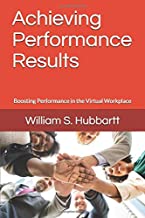By William Carmichael
Many of us are right in the middle of the performance evaluation process. A deadline, no doubt driven by the accounting department, has been placed squarely on our shoulders. The pressure to complete this annual ritual is real, unrelenting, and somewhat disconcerting. And thinking back to this time last year, we swore we would be ahead of the curve next time! Many of us also think about the concept of performance ratings, as vague and outdated as we would like to agree, seem to apply even though overused. Well, if all this sounds painfully familiar, it doesn’t have to. Achieving Performance Results: Boosting Performance in the Virtual Workplace by William S. Hubbartt, is a timely, relevant reference guide to the performance management process as well as the employee relations requirement that any manager or supervisor will immediately benefit from.
What’s My Role?
Achieving Performance Results takes an interesting approach to this question by immediately placing us into a new leadership assignment at the very beginning of the book. True, being a subject-matter-expert got us here but something about this opportunity is different. New skill-sets such as planning, scheduling, coordinating, facilitating and motivating are required and perhaps most significantly, performance management will be expected. It also causes to question performance expectations in a new and different light. This realistic scenario is clearly one the author is comfortable placing us in and does a masterful job of anticipating our questions, such as:
- How can I get better results from my team members?
- What’s the secret for dealing with the new generation of workers?
- How can I effectively manage a virtual work team of people I don’t even know?
- What is the best way to deal with an employee who doesn’t seem to fit in?
- What is the best way to measure results?
- Management says that it “pays for performance,” but how can I apply that to my team?
- How can I get rid of a team member who just does not do the job?
Regardless of your seniority or experience, this book is a handy reference guide on the performance management process. It has been developed to guide the Team Leader or Supervisor to improve performance results and to better correlate those results to rewards for virtual and on-site employees. It provides useful tips, ideas, and checklists to motivate team members, boost performance, address performance problems, assure meaningful performance discussions, avoid legal pitfalls and to better correlate rewards with performance.
Is Money Always a Performance Motivator?
Achieving Performance Results contains many timely, performance-related topics but I specifically liked how the author addresses the money as a performance factor in the book. Let’s face it, the topic of money and other financial incentives too often permeates performance evaluation dialogue, when in fact, it doesn’t have to. As Hubbartt attests, “Team leaders and supervisors need to clearly communicate the distinction between performance discussions and pay adjustment discussions.” What readers will find in this one section is a plethora of realistic scenarios that cover the gamut of pay and salary-related issues. Here, the author addresses: tips for discussing pay, no increases, how to avoid promises about future pay, and most importantly, the motivational factors each employee brings with them.
Hubbartt also provides an informative look at team dynamics as motivators, changing employment relationships, the need for contingent workforces, and the critical need for team leaders to improve their interaction skills so that improved performance results occur.
Structure and Layout
Readers will find that Achieving Performance Results: Boosting Performance in the Virtual Workplace was written as a user-friendly field guide. As a former Federal Investigator for the Equal Employment Opportunity Commission who handled investigations and achieved resolutions of employment discrimination complaints, there is a logical approach Hubbartt brings to the table. For example, instead of numbered chapters, the author instead provides a listing of topics readers will identify with. Regarding the aforementioned topic of pay, which is placed toward the latter portion of the book, the evolution of the workplace, employment relationships, employee responsibilities and virtual team requirements are mentioned earlier. The author has taken a structured approach to the subject at hand. Once you’ve gone through the book, you can go back to any section for a deeper reading. The objective of the book is stated clearly, followed by a review of the latest trends in the workplace.
The language is simple and understandable. The content is not just useful, but also interesting as the book is packed with relevant findings from research studies and company initiatives. It provides useful tips, ideas, and checklists to motivate team members, boost performance, address performance problems, assure meaningful performance discussions, avoid legal pitfalls, and suggestions on how to better correlate rewards with performance. Readers will also find a sense of novelty in the book’s layout and content design. Each topic contains a useful summary at the end as well as helpful case examples. Apart from its use of black and white images, I found it to be a very practical guide for seasoned and novice managers alike.
Who Will Benefit Most from This Book?
Human Resource Professionals, Corporate Trainers, Team Leaders and Supervisors.
About the author:
William S. Hubbartt MSPR, SPHR, has over 30 years of experience in human resource management including positions in industry, corporate, education, government and consulting. Hubbartt holds a MS Degree in Industrial Relations from Loyola University of Chicago. He was awarded a lifetime accreditation as a Senior Professional in Human Resources (SPHR), from the Human Resource Certification Institute.

Ed.D
Higher Education Administrator
wcarmchl@gmail.com
